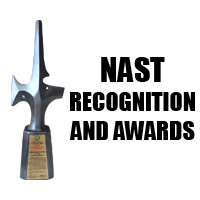The National Academy of Science and Technology, Philippines (NAST PHL) held a Science Policy and Information Forum (SPIF) on the Sustainability of Manila Bay last May 29, 2019 at the Philippine International Convention Center (PICC) in Pasay City.
The conduct of the Forum is in support of NAST PHL’s mandate to provide research-backed recommendations to the government and the public on matters related to science and technology.
Attended by around 75 participants from government agencies, local government units, academic institutions, non-governmental organizations, and media personnel, the Forum served as an avenue to learn about the status of the various plans for Manila Bay, gather science-based recommendations, and elicit discussions in relation to its sustainability.
Updates on ports development, rehabilitation efforts
Officials from the Department of Environment and Natural Resources (DENR) and the Philippine Ports Authority (PPA) laid out some updates regarding the cleanup status and the ports development, respectively, in the Manila Bay area.
The Deputy Executive Director of the Manila Bay Coordinating Office (MBCO), Mr. Jacob Meimban Jr., gave updates on the cleanup of Manila Bay. The MBCO, an attached office of the DENR, is one of the agencies in charge of coordinating the rehabilitation of Manila Bay and the dozens of waterways along its area (e.g. esteros in Manila). Meimban called on to ramp up the focus on ecosystem improvement and informal settler resettlement.
“The challenge is still on cleaning up the tributaries that exit into the bay. Many informal settlers are still living near those waterways and continuously discharge their wastes directly into the water,” Meimban added.
He also lamented that Manila Bay has already become the septic tank of greater Manila area although due to the efforts of everybody, they recorded reductions in fecal coliform levels of the Bay.
Considering the rich history of trade in the Manila Bay area, NAST PHL also invited the PPA to give an update on the ongoing ports development activities. Mr. Eligio Fortajada, acting manager of the Port Management Office – NCR South under PPA, outlined some of their projects which include the expansion of the Manila International Container Terminal, the developments for Laguna Gateway Inland Container Terminal and Cavite Gateway Terminal, and improvements in the Manila North Harbor.
Future plans for Manila Bay
Representatives from the National Economic and Development Authority (NEDA) also briefed the attendees regarding the “Manila Bay Sustainable Development Master Plan (MBSDMP)”, which could be the basis of the government’s future actions towards Manila Bay
Mr. Kevin Gilbert Manzano, a Senior Economic Development Specialist from the NEDA Infrastructure Staff, gave an overview of the formulation of the master plan. He also shared the milestones of the plan formulation which will culminate in the submission of a final master plan report.
One of the focal persons in the formulation of the master plan is Mr. Jan Jaap Brinkman, leader of the MBSDMP Study Team. Mr. Brinkman along with experts from the Netherlands was tapped by the Philippine government, in partnership with the Dutch government, to study and assess the status of Manila Bay and come up with recommendations in managing the area.
“We see the relevance of what we do because more than 30 million people live near Manila Bay and can be greatly affected, either positively or negatively, by the outcome of what people will do to it.”
Mr. Brinkman also clarified to the audience that what they are formulating is a management plan, and not a development plan, contrary to what some sectors thought.
Reclamation projects
The major issue haunting the status of Manila Bay is the various reclamation projects being floated in the news reports. Atty. Joseph John Literal, the Assistant General Manager for Reclamation and Regulation of the Philippine Reclamation Authority (PRA), reported on the status of various reclamation projects in the area. Based on his report, the 21 proposed projects, a big majority of which was rolled-out over the last three years, comprise 4.7% of the total area of the bay. However, Atty. Literal clarified that some of those projects are not approved yet.
Science community views
Representatives of the science community also gave advice on the nature of Manila Bay and its implications to the bay’s management. The Manila Bay, enjoyed by many for its beautiful sunset, is becoming over enriched with minerals and nutrients, according to NAST Academician and physical oceanography expert Dr. Cesar L. Villanoy. This process called eutrophication includes the excessive growth of algae which results to water stagnation and reduction of oxygen levels.
Furthermore, Dr. Villanoy also discussed the physical nature of Manila Bay. The bay’s wider head and narrow exit slow down the exchange of water in and out of the bay, thus, increasing the chances of pollutants to stay longer in the bay. Dr. Villanoy also said that reduced oxygen levels can only support a fewer number of life forms and suggested that the government address the sources of pollutants, and carefully study the reclamation projects.
In addition, chemical oceanography expert and UP Marine Science Institute professor Dr. Gil Jacinto pointed to the untreated domestic sewage and dysfunctional septage management as the drivers of pollution in Manila Bay area. He also mentioned the proliferation of dishwashing and laundry detergents with phosphates, as a contributor to its pollution. Dr. Jacinto, also an Outstanding Young Scientist awardee of NAST in 1994, recommended the improvement of the sewage treatment in the surrounding areas and proper waste management to avoid catastrophic situations.
Moving forward
Academician Rhodora V. Azanza, NAST PHL President, assured the participants of NAST’s commitment to support the rehabilitation efforts in Manila Bay through the provision of policy advice and scientific expertise.
“[We] acknowledge the political will of President Rodrigo Duterte and DENR Secretary Roy Cimatu in cleaning up Manila Bay,” Academician Azanza said in her remarks.
Academician Azanza also reaffirmed NAST’s commitment to the endeavor and expressed hope for a united action to move forward for the bay’s sustainability and “restore the glory of the Manila Bay we all love.”
The National Academy of Science and Technology, Philippines (NAST PHL), an attached agency to the Department of Science and Technology (DOST), is the premier recognition and advisory body in the Philippines on matters related to science and technology.











